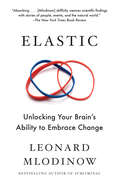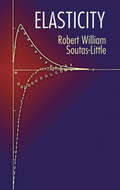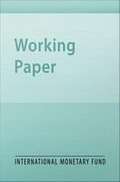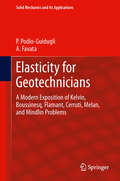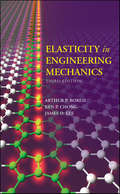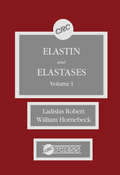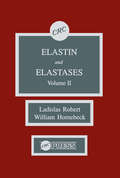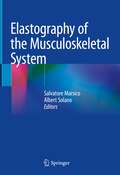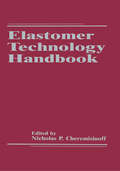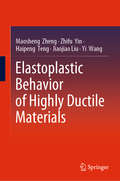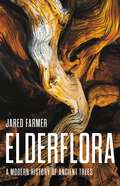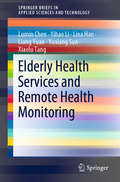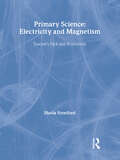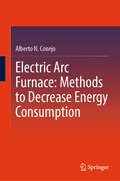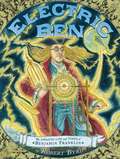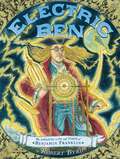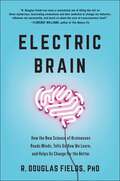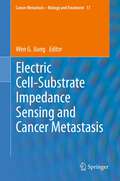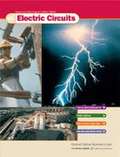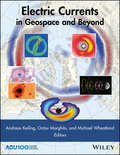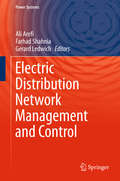- Table View
- List View
Elastic: Flexible Thinking in a Time of Change
by Leonard MlodinowFrom the best-selling author of Subliminal and The Drunkard’s Walk comes a groundbreaking look at the psychology and neuroscience of change, and at how tapping into elastic thinking will help us thrive in the modern world. <P><P>Drawing on cutting-edge research, Leonard Mlodinow takes us on an illuminating journey through the mechanics of our minds as we navigate the rapidly changing landscapes around us. <P><P>Out of the exploratory instincts that allowed our ancestors to prosper hundreds of thousands of years ago, humans developed a cognitive style that Mlodinow terms elastic thinking, a unique set of talents that include neophilia (an affinity for novelty), schizotypy (a tendency toward unusual perception), imagination and idea generation, and divergent and integrative thinking. <P><P>These are the qualities that enabled innovators from Mary Shelley to Miles Davis, from the inventor of jumbo-sized popcorn to the creators of Pokémon Go, to effect paradigm shifts in our culture and society. <P><P>In our age of unprecedented technological innovation and social change, it is more important than ever to encourage these abilities and traits.How can we train our brains to be more comfortable when confronting change and more adept at innovation? How do our brains generate new ideas, and how can we nurture that process? Why can diversity and even discord be beneficial to our thought process? <P>With his keen acumen and quick wit, Leonard Mlodinow gives us the essential tools to harness the power of elastic thinking in an endlessly dynamic world.
Elasticity (Dover Books on Physics)
by Robert William Soutas-LittleAccording to the author, elasticity may be viewed in many ways. For some, it is a dusty, classical subject . . . to others it is the paradise of mathematics." But, he concludes, the subject of elasticity is really "an entity itself," a unified subject deserving comprehensive treatment. He gives elasticity that full treatment in this valuable and instructive text. In his preface, Soutas-Little offers a brief survey of the development of the theory of elasticity, the major mathematical formulation of which was developed in the 19th century after the first concept was proposed by Robert Hooke in 1678. The theory was further refined in the 20th century as a means of solving the equations presented earlier.The book is divided into three major sections. The first section presents a review of mathematical notation and continuum mechanics, covering vectors and tensors, kinematics, stress, basic equations of continuum mechanics, and linear elasticity. The second section, on two-dimensional elasticity, treats the general theory of plane elasticity, problems in Cartesian coordinates, problems in polar coordinates, complex variable solutions, finite difference and finite element methods, and energy theorems and variational techniques. Section three discusses three-dimensional problems, and is devoted to Saint Venant torsion and bending theory, the Navier equation and the Galerkin vector, and the Papkovich-Neuber solution.Numerous illustrative figures and tables appear throughout the book, and valuable reference material is provided in the appendices on eigenfunction analysis, trigonometric functions, Fourier transforms, inverse transforms, complex variable formulae, Hankel transforms, and Bessel and Legendre functions.Instructors will find this an ideal text for a two-course sequence in elasticity; they can also use it as a basic introduction to the subject by selecting appropriate sections of each part.
Elasticity for Geotechnicians
by Paolo Podio-Guidugli Antonino FavataThis book deals in a modern manner with a family of named problems from an old and mature subject, classical elasticity. These problems are formulated over either a half or the whole of a linearly elastic and isotropic two- or three-dimensional space, subject to loads concentrated at points or lines. The discussion of each problem begins with a careful examination of the prevailing symmetries, and proceeds with inverting the canonical order, in that it moves from a search for balanced stress fields to the associated strain and displacement fields. The book, although slim, is fairly well self-contained; the only prerequisite is a reasonable familiarity with linear algebra (in particular, manipulation of vectors and tensors) and with the usual differential operators of mathematical physics (gradient, divergence, curl, and Laplacian); the few nonstandard notions are introduced with care. Support material for all parts of the book is found in the final Appendix.
Elasticity in Engineering Mechanics
by Arthur P. Boresi Kenneth P. ChongElasticity in Engineering Mechanics has been prized by many aspiring and practicing engineers as an easy-to-navigate guide to an area of engineering science that is fundamental to aeronautical, civil, and mechanical engineering, and to other branches of engineering. With its focus not only on elasticity theory, including nano- and biomechanics, but also on concrete applications in real engineering situations, this acclaimed work is a core text in a spectrum of courses at both the undergraduate and graduate levels, and a superior reference for engineering professionals.
Elastin and Elastases, Volume I
by Ladislas Robert William HornebeckWritten by internationally known European and American scientists, these volumes systematically present many topics in the elastin and elastases fields. Volume I explains elastin, its biosynthesis, physicochemical properties, and alteration in a variety of pathologies and with aging. Volume II describes elastases, their physiological and pathological roles and their control by natural and synthetic inhibitors. Filled with illustrations and figures, these volumes will benefit researchers, physicians, and industrial scientists.
Elastin and Elastases, Volume II
by Ladislas Robert William HornebeckWritten by internationally known European and American scientists, these volumes systematically present many topics in the elastin and elastases fields. Volume I explains elastin, its biosynthesis, physicochemical properties, and alteration in a variety of pathologies and with aging. Volume II describes elastases, their physiological and pathological roles and their control by natural and synthetic inhibitors. Filled with illustrations and figures, these volumes will benefit researchers, physicians, and industrial scientists.
Elastography of the Musculoskeletal System
by Salvatore Marsico Albert SolanoIn this book recognized world-renowned expert authors expose the state of the art on musculoskeletal ultrasound elastography.Low cost, wide dissemination and accuracy in the evaluation of the musculoskeletal structures, nerves, periosseous soft parts, vascular structures, together with the possibility of performing real time dynamic studies, made the ultrasound technique widely spread among sonographers and musculoskeletal radiologists.Each chapter presents a description of the elastographic semiotics of the main pathologies of the musculoskeletal system and soft tissue, images that represent both routine and more complex clinical cases in a practical and schematic way and summary tables on the characteristics in terms of elasticity found in the main pathologies.A wealth of color images as well as dynamic images and tables complete the book, that will be a useful tool for sonographers , radiologists, orthopedists, sports medicine specialists wishing to expand their knowledge on ultrasound elastography.
Elastomer Technology Handbook
by Nicholas P. Cheremisinoff Paul N. CheremisinoffElastomer Technology Handbook is a major new reference on the science and technology of engineered elastomers. This contributed volume features some of the latest work by international experts in polymer science and rubber technology. Topics covered include theoretical and practical information on characterizing rubbers, designing engineering elastomers for consumer and engineering applications, properties testing, chemical and physical property characterization, polymerization chemistry, rubber processing and fabrication methods, and rheological characterization. The book also highlights both conventional and emerging market applications for synthetic rubber products and emphasizes the latest technology advancements. Elastomer Technology Handbook is a "must have" book for polymer researchers and engineers. It will also benefit anyone involved in the handling, manufacturing, processing, and designing of synthetic rubbers.
Elastoplastic Behavior of Highly Ductile Materials
by Yi Wang Maosheng Zheng Zhifu Yin Haipeng Teng Jiaojiao LiuThis book mainly introduces some basic phenomena and laws of highly ductile materials during elastoplastic deformation, and their engineering applications, such as the transfer and relief of stress concentration in the notch root, the mitigation of possible brittle fracture, the ductile deformation and damage, fatigue, energy absorption, plastic buckling, thermal stress problems, etc. It shows a number of revolutions in modern applications and design, which are beneficial to the safety of modern equipment, and improve applicability. In addition, the first three chapters of this book also briefly introduce the basic knowledge of elastoplastic deformation and analysis as a preliminary knowledge. This book can be used as a textbook for advanced undergraduate students and postgraduate in non-mechanics majors such as mechanical engineering, power, material or civil engineering, as well as scholars and engineers in related fields.
Elastoplasticity Theory
by Vlado A. LubardaUnderstanding the elastoplastic deformation of metals and geomaterials, including the constitutive description of the materials and analysis of structure undergoing plastic deformation, is an essential part of the background required by mechanical, civil, and geotechnical engineers as well as materials scientists. However, most books address the su
Elderflora: A Modern History of Ancient Trees
by Jared FarmerThe epic story of the planet&’s oldest trees and the making of the modern world Humans have always revered long-lived trees. But as historian Jared Farmer reveals in Elderflora, our veneration took a modern turn in the eighteenth century, when naturalists embarked on a quest to locate and precisely date the oldest living things on earth. The new science of tree time prompted travelers to visit ancient specimens and conservationists to protect sacred groves. Exploitation accompanied sanctification, as old-growth forests succumbed to imperial expansion and the industrial revolution. Taking us from Lebanon to New Zealand to California, Farmer surveys the complex history of the world&’s oldest trees, including voices of Indigenous peoples, religious figures, and contemporary scientists who study elderflora in crisis. In a changing climate, a long future is still possible, Farmer shows, but only if we give care to young things that might grow old.
Elderly Health Services and Remote Health Monitoring (SpringerBriefs in Applied Sciences and Technology)
by Lina Han Yihao Li Lumin Chen Liang Yuan Yuxiang Sun Xiaolu TangThis book focuses on typical health services and remote monitoring methods, such as visual recognition and deep learning. Chiefly addressing the design and simulation of rehabilitation devices, and the evaluation of their effects on various diseases, it offers a valuable resource for professional researchers and graduate students in the fields of elderly medicine, signal processing, and rehabilitation.
Elect&Mag Prim Sci: Teacher's Cd-rom Pack For Key Stages 1 And 2
by Fabienne Brochier Mike Diprose Nabeel Nasser Sheila StratfordFirst published in 2004. Routledge is an imprint of Taylor & Francis, an informa company.
Electric Arc Furnace Steelmaking with Submerged Mixed Injection
by Rong Zhu Guangsheng WeiThis book focuses on the study of electric arc furnace (EAF) steelmaking with submerged injection. The new EAF process with submerged mixed injection was first proposed and applied by the authors. It analyzes the mechanism of submerged O2-CaO and carbon powder injection, the impact characteristics of submerged gas-solid injection and the fluid flow characteristics of EAF molten bath with submerged gas-solid injection. The industrial application of EAF steelmaking with submerged gas-solid injection was introduced. Finally, the book reviews the recent innovations and advances of injection metallurgy in EAF steelmaking. It also proposes a possible future process for cyclic utilization of CO2 in EAF-LF steelmaking process. This book provides basic data support for the industrial application of EAF steelmaking with submerged mixed injection for researchers, engineering and technical personnel and industrial professionals.
Electric Arc Furnace: Methods to Decrease Energy Consumption
by Alberto N. ConejoThe Electric Arc Furnace (EAF) will become the largest producer of steel worldwide, replacing the conventional route through the blast furnace and BOF. In most developed countries the EAF process is already the main steelmaking reactor. This is due to many advantages, such as much lower emissions of CO₂, higher flexibility in furnace capacity and higher flexibility in the raw materials such as scrap, direct reduced iron (DRI) and pig iron. The EAF process has also experienced a larger level of automation that provides a higher productivity. However, the EAF process also has a large number of limitations in comparison with the BOF, for example; (1) use of an expensive type of energy (electric energy), (2) very poor stirring conditions which results in lower decarburization rates, (3) residual elements in steel scrap, (4) cost of scrap can be higher than iron ore, (5) dependance on DRI to produce higher quality steels, (6) higher heat losses, (7) lower metallic yield (slag leaves the furnace losing iron and heat). If the EAF process overcomes these limitations it will be able to fully overcome the BF-BOF route and become the dominant process for steelmaking in the 21st century. This book discusses in detail 15 methods to decrease energy consumption in the EAF. Decreasing energy consumption requires an integral approach which means that all methods should be fully understood and optimized.
Electric Ben: The Amazing Life and Times of Benjamin Franklin
by Robert ByrdBeing one of the most far-sighted of the early American leaders, Benjamin Franklin possessed a brilliant, questioning mind which drove him to achieve success in a remarkable variety of enterprises--as a scientist, writer, inventor, philosopher, publisher, and statesman. <P><P> Winner of the Sibert Honor
Electric Ben: The Amazing Life and Times of Benjamin Franklin
by Robert ByrdElectric Ben is now a 2013 Boston Globe-Horn Book Nonfiction Book Award Winner, a Kirkus Reviews Best Children's Book, a Horn Fanfare Book, and a Robert F. Sibert Honor book!“a true standout…bright, witty, informative and cleverly organized as the man himself.” – The New York TimesA true Renaissance man, Benjamin Franklin was the first American celebrity. In pictures and text, master artist Robert Byrd documents Franklin's numerous and diverse accomplishments, from framing the Constitution to creating bifocals. The witty, wise, and endlessly curious Franklin is the perfect subject for Byrd's lively style and vibrant art. The pages pulse with facts, quotes, and captions, while the inventive design and intricately detailed illustrations make a striking tribute to the brilliant American.
Electric Brain Signals: Foundations and Applications of Biophysical Modeling
by Geir Halnes Torbjørn V. Ness Solveig Næss Espen Hagen Klas H. Pettersen Gaute T. EinevollIt is common to study the electric activity of neurons by measuring the electric potential in the extracellular space of the brain. However, interpreting such measurements requires knowledge of the biophysics underlying the electric signals. Written by leading experts in the field, this volume presents the biophysical foundations of the signals as well as results from long-term research into biophysics-based forward-modeling of extracellular brain signals. This includes applications using the open-source simulation tool LFPy, developed and provided by the authors. Starting with the physical theory of electricity in the brain, this book explains how this theory is used to simulate neuronal activity and the resulting extracellular potentials. Example applications of the theory to model representations of real neural systems are included throughout, making this an invaluable resource for students and scientists who wish to understand the brain through analysis of electric brain signals, using biophysics-based modeling.
Electric Brain: How the New Science of Brainwaves Reads Minds, Tells Us How We Learn, and Helps Us Change for the Better
by R. Douglas Fields2020 Foreword Indie Award Winner in the "Science & Technology" Category What is as unique as your fingerprints and more revealing than your diary? Hint: Your body is emitting them right now and has been every single day of your life. Brainwaves. Analyzing brainwaves, the imperceptible waves of electricity surging across your scalp, has been possible for nearly a century. But only now are neuroscientists becoming aware of the wealth of information brainwaves hold about a person's life, thoughts, and future health. From the moment a reclusive German doctor discovered waves of electricity radiating from the heads of his patients in the 1920s, brainwaves have sparked astonishment and intrigue, yet the significance of the discovery and its momentous implications have been poorly understood. Now, it is clear that these silent broadcasts can actually reveal a stunning wealth of information about any one of us. In Electric Brain, world-renowned neuroscientist and author R. Douglas Fields takes us on an enthralling journey into the world of brainwaves, detailing how new brain science could fundamentally change society, separating fact from hyperbole along the way. In this eye-opening and in-depth look at the most recent findings in brain science, Fields explores groundbreaking research that shows brainwaves can: Reveal the type of brain you have—its strengths and weaknesses and your aptitude for learning different types of information Allow scientists to watch your brain learn, glean your intelligence, and even tell how adventurous you are Expose hidden dysfunctions—including signifiers of mental illness and neurological disorders Render your thoughts and transmit them to machines and back from machines into your brain Meld minds by telepathically transmitting information from one brain to another Enable individuals to rewire their own brains and improve cognitive performance Written by one of the neuroscientists on the cutting edge of brainwave research, Electric Brain tells a fascinating and obscure story of discovery, explains the latest science, and looks to the future—and the exciting possibilities in store for medicine, technology, and our understanding of ourselves.
Electric Cell-Substrate Impedance Sensing and Cancer Metastasis
by Wen G. JiangCell based impedance sensing is becoming a new biophysical and cellular technology in cell based analyses. The technology has been used in investigation of cellular growth and death, cell adhesion and migration, cell invasion and cell-cell interactions, cell toxicity, angiogenesis, cell permeability, signal transduction and cellular behaviour under flow conditions. It is a probe free, highly sensitive, and versatile technology platform. Recent development in the technology has also allowed high throughput, automated analyses. It has been widely explored in chemistry, toxicity, cell biology, cancer biology, and other areas of chemistry, medicinal chemistry, life and medical science. Written by experts in the area of cell impedance sensing, including the Nobel Laureate Dr Ivar Giaever, this books covers the background of electric cell-substrate impedance sensing, their applications in cell based investigations, particularly in the area of cancer biology. This book is the first on this technology platform and will be a highly useful reference for molecular and cell biologists, cancer biologists, chemists and biochemists, clinical researchers who work in the areas of cell biology, molecular biology, toxicology, pharmaceutical industry, life science and medical research.
Electric Circuits
by National Science Resources CenterElectric Circuits gives 4th and 5th graders an overview of electricity¿how it was discovered, how people put it to work, how it works in living organisms, and what scientists are still learning about it. The book opens with the time-honored story of Benjamin Franklin and his experiments which proved that lightning is a form of electricity. Another story tells of the American inventor Thomas Edison, whose practical application of electricity has helped shape the modern world. One section of this book outlines the path that electricity takes from a power plant to the living room. Finally, the book looks at electricity in nature, from electric eels in the water to lightning in the skies. (Spanish version)
Electric Circuits KitBook
by David M. Jones Ed BasconiThis KitBook provides an introduction to electricity and electric circuits.
Electric Currents in Geospace and Beyond (Geophysical Monograph Series #235)
by Andreas Keiling Octav Marghitu Michael WheatlandElectric currents are fundamental to the structure and dynamics of space plasmas, including our own near-Earth space environment, or “geospace.” This volume takes an integrated approach to the subject of electric currents by incorporating their phenomenology and physics for many regions in one volume. It covers a broad range of topics from the pioneers of electric currents in outer space, to measurement and analysis techniques, and the many types of electric currents.
Electric Distribution Network Management and Control (Power Systems)
by Farhad Shahnia Ali Arefi Gerard LedwichThis book highlights the recent research advances in the area of operation, management and control of electricity distribution networks. It addresses various aspects of distribution network management, including operation, customer engagement and technology accommodation. Electricity distribution networks are an important part of the power delivery system, and the smart control and management of distribution networks is vital in order to satisfy technical, economic, and customer requirements. A new management philosophy, techniques, and methods are essential to handle uncertainties, security, and stability associated with the integration of renewable-based distributed generation units, demand forecast and customer needs. This book discusses these topics in the context of managing the capacity of distribution networks while addressing the future needs of electricity systems. Furthermore, the efficient and economic operation of distribution networks is an essential part of management of system for effective use of resources, and as such the also addresses operation and control approaches and techniques suitable for future distribution networks.
